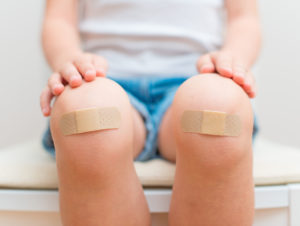 At times, it can feel like children are accident magnets. Here are a few things to know when treating cuts and scrapes or caring for stitches.
At times, it can feel like children are accident magnets. Here are a few things to know when treating cuts and scrapes or caring for stitches.
What is the best way to clean a wound? Cool water is the best way to clean a scrape, cut or puncture wound. After you have thoroughly rinsed the wound with cool water, use soap and a soft wash cloth to clean the area around the wound. Avoid putting soap, hydrogen peroxide or iodine in the wound as it can cause irritation. Remove any dirt that remains in the wound with tweezers that have been cleaned with rubbing alcohol.
Should I be concerned about bleeding? Bleeding is the body’s way of cleaning wounds. Many small cuts and scrapes will stop bleeding in a short time. However, it may take longer for wounds on the face and head to stop bleeding since there are numerous blood vessels in that area.
Applying firm, gentle pressure to the affected area with a clean cloth will stop the bleeding. Add more tissue or gauze over the wound if the blood begins to soak through, and apply constant pressure for 20- 30 minutes. Do not remove the previous cloth. If the wound is on your arm or leg, raising it above your heart will help to stop the bleeding.
Is antibiotic ointment necessary? Antibiotic ointments help to block infection while keeping the wound clean and moist. Minor cuts will typically heal without the use of an antibiotic ointment, but it can help reduce scarring when the wound closes.
What is the purpose of a scab? A scab is the body’s natural way of bandaging itself and protecting against dirt in the wound. Scabs will fall off by themselves when they are ready, so it is best not the pick at them.
Should I use a bandage? Band-Aids or gauze and adhesive tape should be used to cover wounds in exposed areas or in areas that could be irritated by clothing. Remember to change the bandage daily to keep the wound dry and clean. If the wound is in an unexposed area, leaving it uncovered will help it to dry and heal faster.
Occlusive and semiocclusive bandages are designed for large scrapes. These wound coverings will keep the area moist and clean while reducing scarring and speeding the healing process. Butterfly strips can also be used to close small cuts.
Do I need to call the doctor? If the wound is deep, the edges are jagged or any of the following occur, you should seek medical care.
- The wound is jagged
- Red streaks have formed near the wound
- The wound occurred on your face
- Bleeding doesn’t stop within 20 minutes of direct pressure
- The cut gapes open on the edges
- There is dirt within the cut
- The cut and area surrounding it become tender or inflamed
- There is drainage seeping from the wound
- A temperature over 100 degrees occurs
- There is numbness surrounding the wound
What is the best way to care for stitches? Wait 1 to 3 days to wash the wound after it has been stitched. Keeping the area free from dirt and crust will reduce scarring. Thoroughly dry the area after washing. Elevating the wound above your heart will reduce swelling and pain in addition to speed the healing process. If the wound is draining, a bandage may be necessary.
